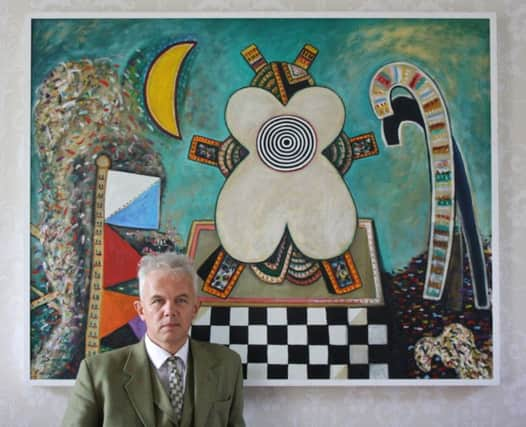Harrogate art gallery’s tribute to 20th century master


Among the small band of mourners at the funeral of artist Alan Davie CBE last year at a crematorium in Steveange was a Harrogate man.
“It was a small, quiet service, “ said gallery owner and art dealer Andrew Stewart, “there were only about 50 to 60 people there. But his memorial at Tate Britain attracted a large number of great and influential artists and musicians, all of them paying homage to this incredible man.
Advertisement
Hide AdAdvertisement
Hide Ad“One of them, the painter Albert Irvin said ‘I didn’t get to meet Picasso but I was privileged to have met Alan Davie.”
Andrew Stewart first met this bearded titan of modern art in the late 1970s long before he set up Harrogate gallery 108 Fine Art where he would later go on to show Davie’s work.
By that point in the mid-Noughties, the reputation of this jazz-loving, glider flying artist with the energy of a small army was starting to rise again after falling foul of the ebbs and flows of fashion.
But when Stewart and Davie’s paths had first crossed in Scotland back in the 70s at a jazz gig in Dundee where Davie was on stage playing wild saxophone, his explosive canvases were still regarded with awe, nearly on a par with the likes of Jackson Pollock and Mark Rotho both of whom had generously trumpeted his talents when abstract expression first set flame to the art world in the post-war years.
Advertisement
Hide AdAdvertisement
Hide AdNow art lovers will have the chance to see what all the fuss was about when 108 Fine Art presents a major new exhibition in tribute later this summer.
This Harrogate gallery’s new season is awash in exciting exhibitions, including sculptors Sally Arnup and Ralph Brown and painters Yukako Sakakura and Norman Adams.
But Alan Davie: A Miraculous Storm 1948-2014, which Stewart spent the last year piecing together, promises to be the ultimate gem.
Put together by Andrew with care after winning the consent of Alan’s family and the support of Gimpel Fils, the leading London gallery who represented Davie from his earliest days, it promises to be the broadest representation of Davie’s career outside London or Edinburgh.
Advertisement
Hide AdAdvertisement
Hide AdAndrew said: “It will be a wonderful cross-section of some of his finest work, including some extremely rare collages and small paintings from the 1940s and 50s to examples of his monumental paintings from the 1960s, the later mystical pictures of the 1970s and the exquisite paintings he produced in his final few years. ”
This time round, there will be no Alan himself but, thanks to Andrew and 108, I did get the chance to meet him myself once at a previous exhibition at this Harrogate gallery.
Then in his late 80s, Davie was born, like myself, in Grangemouth on the banks of the River Forth. He’d been the only famous person I’d ever heard of to hail from my hometown when I was growing up.
Grangemouth may a port but it’s not a particularly worldly place and Davie’s life story is as much an act of transcendence as the Zen Buddhism which influenced his work.
Advertisement
Hide AdAdvertisement
Hide AdA graduate of Edinburgh College of Art, after serving in the Royal Artillery in the Second World War he travelled across Italy on a scholarship.
It’s here he was to meet influential art collector Peggy Guggenheim who not only recommended Davie to Gimpel Fils gallery but some of her own clients, including Pollock and Rothko.
From there lay New York and international fame. He had a house in St Lucia in the Caribbean and studios in Cornwall and Hertford, which is where Andrew Stewart ventured in 2003 to establish the special bond which was maintained to the day Davie died last year aged 93.
Although he did return to Scotland after those exciting days of international acclaim in the 1950s, to my knowledge Alan Davie never spent much time in Grangemouth after leaving as a young student in the 1930s.
Advertisement
Hide AdAdvertisement
Hide AdLike all mavericks who seek to achieve anything, he had outgrown his roots.
Andrew said: “He was busy working on beautiful little ink drawings up until a few days before his death. Although his health was failing by this point, the images he produced continued to sparkle with great vitality, youthfulness and clarity of vision.”